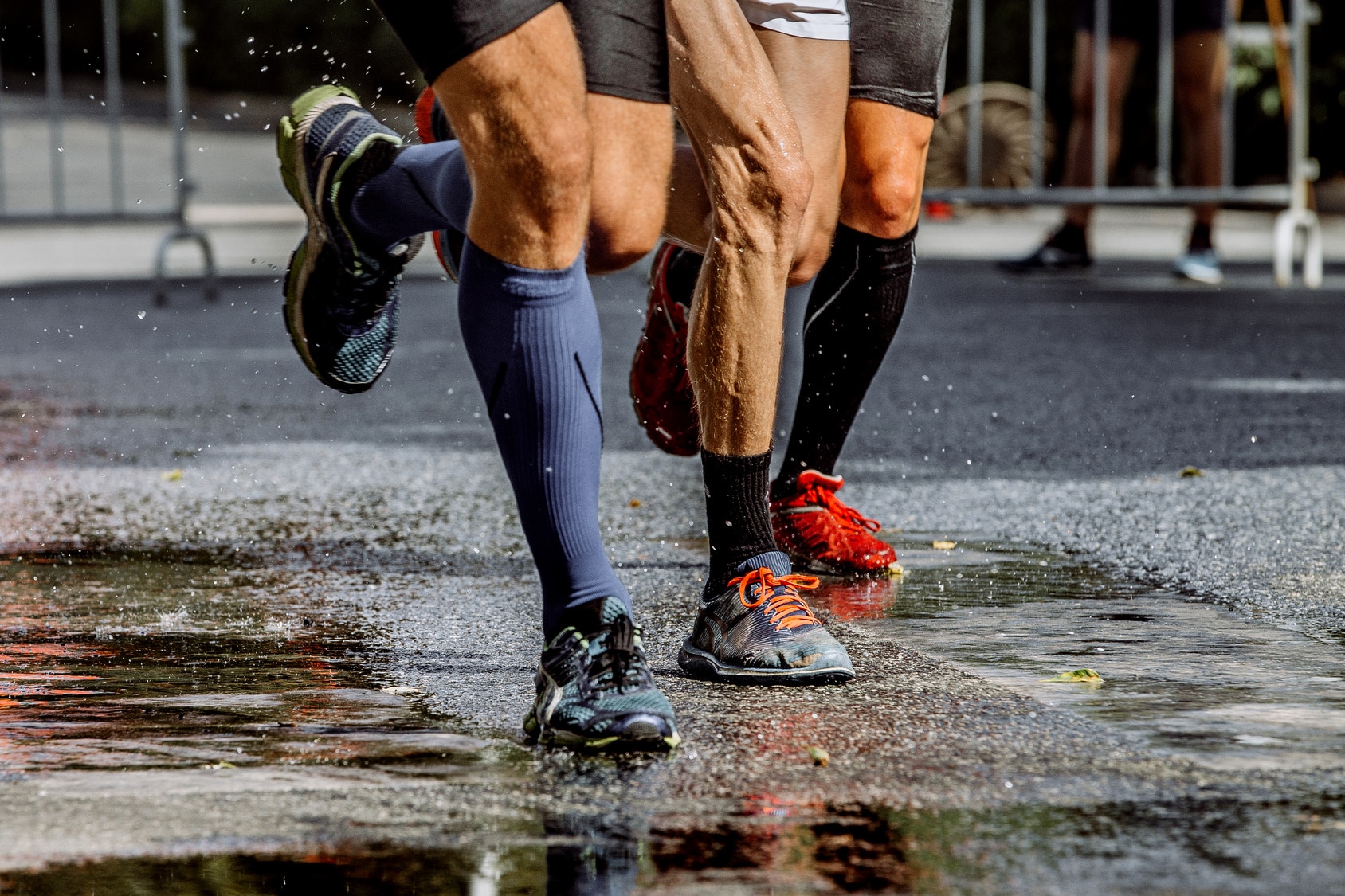Do you often feel discomfort while running? It could be caused by ill-fitting and improper running socks. Wearing the right pair of running socks is essential for the safety and performance of female runners. You will learn the importance of wearing proper running socks in this guide. So get ready to have a blister-free and comfortable running experience!
Running socks can have a major influence on how comfortable and successful your run is. During this activity, you’ll be pushing your feet hard. Ill-fitting and improper socks may cause blisters and pain, while the right ones will keep your feet dry and secure as you run.
As an avid runner, it’s important to understand the importance of wearing running socks designed specifically for women. In this guide, we’ll examine different types of running socks available, factors that influence their effectiveness when you’re out pounding the pavement, and the importance of proper foot care. By understanding the nuances of each type of sock and learning about their benefits, you can make an informed decision about which pair is best for you.
Explanation of the importance of proper running socks for women
For many women, running is an important part of their daily routine. However, running can also be uncomfortable if the wrong type of shoes or socks are worn. Running requires that the feet be adequately supported and that the material used to create the socks be made from breathable fabrics and have features like arch support and cushioning. Additionally, finding a pair of running socks specifically designed for women can help ensure that a woman’s foot is well-protected during her runs.
Properly fitted running socks provide specific benefits for female athletes. The right pair of socks helps keep feet comfortable and prevents sweaty feet and blisters, which can happen when sweat accumulates between skin and socks while moving long distances. To prevent chafing, look for moisture-wicking fabrics as well as construction elements like mesh panels or padded seams that provide comfort while keeping the skin irritation-free.
It’s also best to wear running socks made with natural fibers like wool, cotton or bamboo rather than synthetic ones. These types of material help keep feet cool in hot temperatures while helping to trap heat in colder temperatures better than synthetic materials do. Natural fibers are also better at keeping sweat away from skin so it won’t lead to corn build up or skin blisters either. The great thing about natural fibers is that they are soft against sensitive areas of the foot such as heels, toes and soles thus providing a cushiony feel when your foot hits the ground with each stride–especially important for preventing injuries like fatigue fractures around metatarsal heads (jogger’s toe).
Women should also consider wearing specific performance based socks such as those with reinforced toe protection against abrasions caused by shoes which will support their joints better in order to reduce injury risk. Ultimately women should wear what they find comfortable but there are various types available designed specifically for female runners including compression/graduated compression just around ankle area as they help prevent ankle swelling due to blood pooling; low cut ones perfect for summer jogging; low cushioned models very popular among trail runners; midlength styles ideal after-run recovery options; midweight varieties mostly recommended during cooler weather; knee high designed primarily used by women enjoying cross country skiing; double layers offer more warmth while triple layers usually carry an insulation effect keeping feet warmer despite lower outer fabric density levels… overall dealing with right kind of sock choice will surely make moving on ‘solid’ grounds more pleasant for many dedicated female runners out there!
Benefits of Proper Running Socks
The benefits of wearing running socks specifically designed for women cannot be overstated. Properly fitted running socks are essential for the comfort and health of the wearer, no matter their activity level. While uncomfortable running shoes may be obvious, the dangers of poor-fitting or ill-suited socks often go unnoticed until damage to your skin has already occurred.
Here are some of the key reasons why all female athletes should invest in properly fitting and durable running socks:
– Protection from Blisters: Poorly fitted or low quality socks may chafe and cause blisters on your feet and ankles. Blisters, in turn, can be extremely painful and can disrupt an otherwise successful workout. Investing in quality running socks that wick away moisture while cushions your feet will help protect you from blistering during long workouts.
– Help Feet Breathe: Since female athletes tend to perspire more quickly than males during their workouts, it is important to select a sock material that helps the foot breathe by allowing air to circulate around the foot without allowing moisture to accumulate inside the shoe. Quality running socks with breathable fabrics like polyester and wool will keep feet dryer longer thereby reducing foot fatigue and discomfort at the end of a workout session.
– Comfort & Support: Not only should any pair of running sock fit properly around your feet, they should provide adequate cushioning and support at every step. Look for ones that have additional padding around vulnerable spots such as your heel or arch to minimize any pain associated when you pound the pavement repeatedly throughout a long run or exercise session.
Improved comfort and support
The right pair of running socks can make your runs smoother, more comfortable and more enjoyable. Wearing the wrong running socks can be painful and cause you to experience blisters, chafing and fatigue.
One of the key advantages of women’s running socks is that they provide improved comfort and support. The additional cushioning provided by the extra layers reduces pressure points while also cushioning against impacts during runs on hard surfaces. Improved breathability is another benefit — most running socks are designed to help draw moisture away from the foot and maintain a consistent temperature throughout your run.
Some running socks go beyond comfort with features such as antimicrobial treatments that reduce odor-causing bacteria, reinforced heel and toe boxes for added protection against hot spots, arch support to evenly distribute pressure along the midfoot area, special compression panels to help reduce lactic acid build-up in muscles during long runs and extra padding along ball joints/ligaments for greater joint protection during faster training sessions.
When it comes to choosing the right sock for your next run — or any other activity — comfort must be considered first and foremost. Consider materials like merino wool which is lightweight yet antifungal properties, synthetic fibers designed specifically for enhanced fit or lighter weight alternatives like bamboo rayon or modal blended fabrics that offer superior breathability. Pick up a few different types of women’s running socks so you can test them out before making a purchase – don’t forget to check their fit as well!
Reduced risk of blisters and other foot injuries
Having the right running socks can make all the difference in a successful run. Wearing appropriate running socks helps protect against blisters, hot spots, and other injuries on the feet. Research shows that runners who use specialised running socks experience significantly reduced levels of skin friction and moisture, making them less prone to blisters.
Running socks are typically made with specialised fabric that is designed to transport sweat away from the foot while helping maintain a stable temperature environment. Moisture-wicking materials reduce skin irritation in order to reduce friction and hot spots on the foot, which can turn into painful blisters if left unchecked. Women’s running socks come in various shapes and sizes dependent on their intended purpose for optimal performance.
For example, a sock meant for marathon racing should be thinner with tighter construction than a sock meant for lightweight trail runs or an easier running session such as interval training sessions. Lightweight designs are ideal for sports where you’re likely to need less overall coverage because they give you more freedom of movement without compromising on crucial protection from moisture and scratches. Seamless constructions are also becoming popular since they reduce chafing by eliminating seams between otherwise rough surfaces during tough runs. The unique shape of women’s running socks also provide arch support to reduce discomfort caused by extended wear and long distances on uneven surfaces like trails or cobblestone paths.
Wearing proper running socks is an essential part of any woman’s active lifestyle; it reduces the risk of developing painful foot injuries while keeping your feet well-protected against abrasions and weather conditions like extreme cold or heat. By investing in quality fabric specifically designed for athletic purposes, you can be sure your feet are comfortable enough to get through any run without fuss!
Choosing the Right Running Socks for Women
In order to choose the best running socks for women, it is important to understand the features that should be taken into consideration when selecting a pair of shoes. One should consider both style and function, as well as longevity and comfort.
Style: Consider your individual style when selecting a pair of socks. Do you prefer bright colors or muted tones? Ankle length or over-the-calf length? Understanding your preferences can help in narrowing down the range of choices until you find the right fit.
Function: The right pair of running socks are a key part of your jogger’s outfit – providing insulation, regulating moisture, cushioning pressure points and avoiding blisters. When selecting appropriate running socks, make sure they have features such as compression zones for arch support, anti-bacterial fibers to prevent odor and extra-soft cushioning around the heel and toe areas for maximum security.
Longevity: Calculate how often you plan on using your pair of socks before buying them; this will help guide you towards making a more durable selection that won’t wear out quickly. Also pay attention to reviews describing long-lasting performance when filtering through which options works best for you.
Comfort: Selecting the right type of padded fabric allows your feet to stay comfortable throughout their journey. Your tops must keep your feet feeling low friction and allow proper ventilation while still adhering to their original shape after vigorous usage sessions; thus staying intact on the first few runs despite regularwashing cycles!
Material considerations
When it comes to running, choosing the right socks for your feet is just as important as selecting the right running shoes. Not all running socks are created equal and many materials offer different levels of comfort and performance when training or on race day. Here’s a breakdown of the various materials available and advice on choosing the best running sock for female runners.
Cotton: Cotton is an affordable and often preferred material for everyday use. The fibres are breathable, soft, and lightweight which makes cotton an ideal choice if you’re looking for an economical sock option. However, cotton absorbs moisture quickly which can make your feet feel cold or clammy eventually during longer runs. Additionally, dry cotton fabric can rub against your skin leading to blisters during rigorous activities such as marathon running so it’s best to avoid entirely during those efforts.
Nylon/Synthetic Blends: Generally a mixture of nylon and synthetic fabrics such as spandex, these blends usually make up the more technical knee-length boots purchased specifically for marathon running or triathlons where protection from rubs and friction is desired over breathability. Nylon/synthetic blends wick away moisture quickly due to their light weight properties and tend to illustrate more bold color choices than their monochromatic cousins above them.
Merino Wool: One of the most popular materials used in today’s run market is merino wool – especially among female runners due to the softness of its fibers that lay close against one’s skin while blocking sweat from spreading outside of its intended area while still breathing rather efficiently with its natural holes that allow cooling air in even during extreme temperatures. Merino wool also naturally wicks away odors through its built-in properties so once you have reached the finish line after your long run there will be no lingering smell!
Cushioning and thickness
When it comes to running socks for women, cushioning and thickness are particularly important factors as they tend to have a lower weight than men. This means that the extra cushioning can help prevent blisters, discomfort and reduce the risk of injuries caused by impacting the feet too hard.
The desired thickness will depend on your shoes. Sock liners typically only add a light level of cushioning, so you may want to look for regular or even thicker socks if you are looking for extra support while running.
It is also important to consider your height when looking at sock sizes since taller women may need longer socks in order to provide comfortable coverage and avoid bunching at the ankle area.
Arch support and compression
Arch support and compression are two important factors to consider when choosing the right running socks for women. Arch support helps keep your feet firmly in place as you run, while compression helps reduce swelling throughout your lower legs. Both of these features are particularly beneficial for long-distance runners or those who have a history of foot-related injury or discomfort.
Ideally, look for running socks with an anatomical fit that hugs the curves of your feet, providing secure arch support. This will help reduce fatigue and minimize the risk of blisters. Compression socks use graduated compression to provide a snug fit throughout the ankle, arch, heel and toes that minimizes swelling by increasing circulation of blood flow.
By wearing properly fitted running socks with both arch support and compression, you can reduce fatigue, discomfort and potential injuries during long runs or intense workouts.
Conclusion
In conclusion, the type of sock you choose to wear while running is a very important decision. Not only do the right socks look better and make your runs more comfortable, but they also help keep your feet and legs healthy. From technical options designed with high-tech fabrics to merino wool compression socks that snugly support muscles, there is an ideal sock for every runner.
Be sure to consider all of the important factors when selecting a running sock, such as cushioning and fit, materials used, warmth/breathability and cushioning style. Whether you’re just starting out or a seasoned professional runner, taking these things into account will help ensure you have a safe, healthy, and enjoyable run every time.
FAQ’s
Why are good running socks important?
Good running socks are important because they provide cushioning and support for your feet, help prevent blisters and hotspots, and wick moisture away from your skin to keep your feet dry and comfortable during a run.
Do good running socks make a difference?
Yes, good running socks can make a significant difference in the comfort and performance of your run by providing necessary support and cushioning while also preventing blisters and hotspots.
Do you need to wear running socks?
While it is not required to wear running socks, they can provide important benefits such as cushioning, support, and moisture-wicking to keep your feet comfortable during a run.
Are running socks different from normal socks?
Yes, running socks are different from normal socks as they are designed specifically for the needs of runners, providing additional cushioning, support, and moisture-wicking properties.
Should running socks be tight or loose?
Running socks should fit snugly but not be too tight, as this can restrict blood flow and cause discomfort. It is important to find a sock with a comfortable fit that stays in place during a run.
How often should I change my running socks?
It is recommended to change your running socks every 300-500 miles or when they begin to show signs of wear and tear, such as thinning or holes.
What kind of sock to wear when running?
The best type of sock to wear when running is one specifically designed for running, with cushioning, support, and moisture-wicking properties to keep your feet comfortable during a run.
Why are running socks thick?
Running socks can be thicker than normal socks to provide additional cushioning and support for the feet during a run, which can help prevent blisters and hotspots.
How tight should running socks be?
Running socks should fit snugly but not be too tight, as this can restrict blood flow and cause discomfort. It is important to find a sock with a comfortable fit that stays in place during a run.
What is the best running sock length?
The best running sock length depends on personal preference and the type of running activity. Ankle socks are popular for shorter runs, while mid-calf and knee-high socks can provide additional support for longer runs or trail running.
See Also-
- Best running headlamp
- Best saucony running shoes
- Best running hydration vests
- Best stability running shoes for women
- Best running shirts for men


